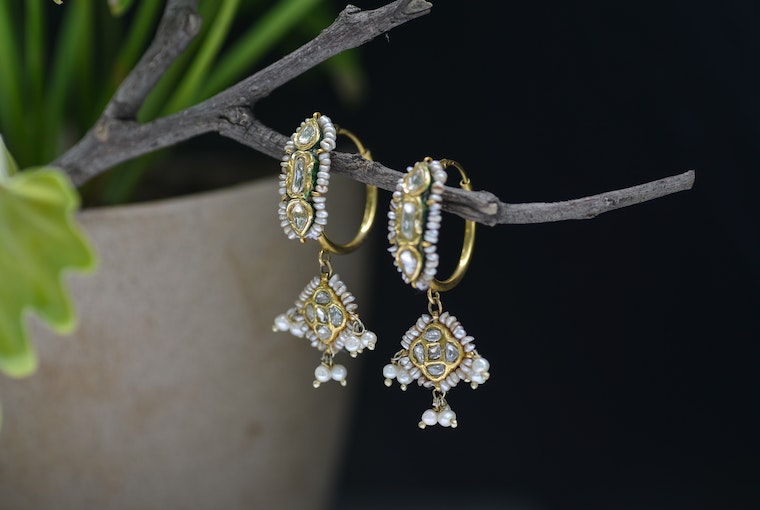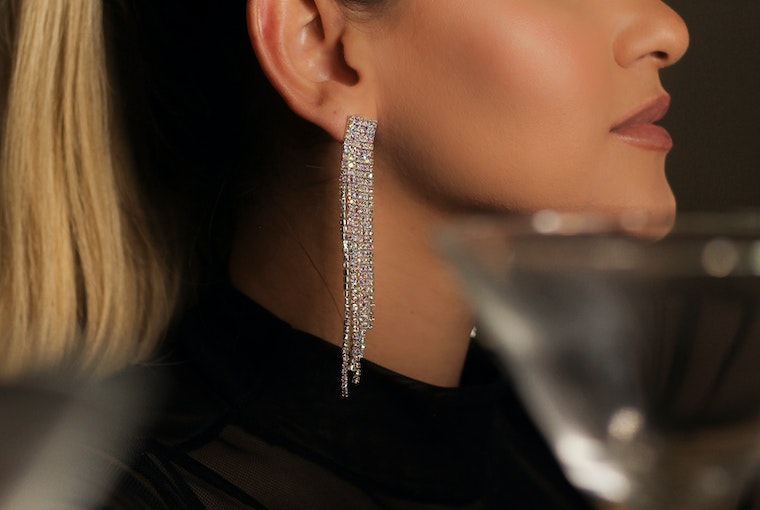Diamond
hat is Polki Diamond? What you need to know
The western jewelry market is seeing a revival in Polki diamonds. This brand of gemstones is being talked about by famous jewelry designers and celebrities. What is a polki-diamond and why does it generate so much buzz?
This article will cover everything you need to know regarding polki. It covers everything from the history of these diamonds and common questions that jewelry enthusiasts have.
Table of Contents
What is a Polki Diamond?
Indian term Polki refers to a natural, raw, uncut and unpolished diamond. As part of the culture and traditions passed down by the Mughals, the art of using raw diamonds as jewelry dates back more than 2,500 years.
Rajput, an Indian upper caste, popularized the use of uncut diamonds in their marriage jewelry. The Indian royals eventually adopted polki. This tradition is alive and well in Rajasthan, which is the largest market for handcrafted jewelry made with uncut and raw diamonds.
Making polki jewelry is now easier than ever. The diamonds are more modern in appearance, with modern cuts like the cushion, round brilliant, and princess.
In the past, polkis could be used in their unfaceted natural form. Many of the polkis used in western jewelry-making today are laser-cut to make proportional pieces. They are also lightly polished and faceted. This results in a more clear and brilliant polkis, with fewer inclusions than traditional ones.
There are three types of polkis: Syndicate (Zimbabwe), and Khilwas (Zimbabwe). Syndicate is the best quality polki. Zimbabwe polki is second. It refers to diamonds from Zimbabwe, Africa. Khilwas are the lowest quality polkis.
Tips for Choosing Polki-Diamonds
The value of Polki diamonds is determined by their color, clarity, treatment, and other characteristics.
Color
Color is the most important factor in choosing a polki-diamond. In their unpolished state, polkis are usually brownish or yellowish. Clearer polkis are more valuable than those with visible color and have a higher value.
Clarity
Clarity is the number of inclusions in a particular diamond. Polki diamonds will show inclusions because they are not polished or faceted. Jewelry designers favor polkis that have the fewest inclusions. The more inclusions there are, the more valuable the diamond. When valuing polki diamonds, clarity is more important than carat weight. Jewelers prefer a raw, uncut diamond that has fewer inclusions to one that has too many and is heavy in carat.
Treatment
Sometimes, polki-diamonds can be treated to improve their appearance. Jewelers may add a small amount of filler to enhance the stone’s clarity or color. Khilwas polki is the hardest to treat because of its visible inclusions and color. It wouldn’t look great when creating commercial-grade jewelry.
What is the difference between natural cut and polki diamonds?
While a polki and cut diamond are fundamentally identical, there are some key differences. They are both natural but traditional polkis are not modified. They are uncut, unpolished and unfaceted.
-cut diamonds, on the other hand, are naturally cut, but are polished, faceted and transformed from a rough, raw state to a beautiful, sought-after gem. Natural cut diamonds are more visible and brighter because of these modifications. The sparkle of the Polki diamonds is gone. Instead, they have a rustic, raw appeal that is becoming increasingly popular in the eastern and western jewelry markets.
Are Polkis worth Buying?
While polki are cut diamonds, they can be more expensive than a cut one. In some cases, however, they may not be worth much. Because polkis are less attractive than diamonds, they tend to have lower color grades, be more cloudy and lack clarity. The GIA doesn’t grade polkis with the 4Cs as they are less valuable than regular cut diamonds.
Is a polki-diamond worth buying in light of all this? These raw diamonds are not worth the money if you plan to sell them later. These uncut and unpolished raw diamonds have no resale value. You cannot sell them back to their owner or anyone else. Like cut diamonds cut diamonds can’t be melted or reused in the same way as polki diamonds.
You can reuse or improve polki jewelry by removing the joints and arranging them differently. This might not work if there is meena work on the jewelry. The meena can cause damage if it isn’t cut up and rejoined.
Although polki jewelry is more expensive than some wedding jewellery, they are still very valuable. Making polkis is a time-consuming and technical process that is expensive.
Although polki diamonds are less expensive than cut diamonds, they can hold a lot of sentimental value, particularly if the piece is passed down as an heirloom. It may not be worth it to invest in polki-diamonds for profit. However, if you’re looking for a piece that exudes old-world charm, you might be able to get value for your investment.
These raw diamonds are used in high-end jewelry and are quickly gaining popularity outside of India. Buyers and sellers are now considering clarity and carat when determining the price of a polki diamond. These uncut and raw diamonds will be more valuable as more people discover about polki.
What is the Difference Between Polki, Kundan, and Jadau?
Although the terms jadau, Kundan, and polki diamond are often interchangeable, they have all different meanings.
Kundan, like polki is an Indian type of jewelry. Kundan is a jewelry made from glass and gemstones. For a refined and shiny appearance, the glass and gemstones are attached to gold foils.
Kundan jewelry’s backside is made using an enameling technique called meenakari. This allows for the jewelry to be worn in both directions.
Kundan jewelry looks extremely expensive due to the beautiful 24k gold that is used in its creation. The jewelry’s actual gold content is very low and the gemstones tends to dominate the jewelry. Kundan isn’t as expensive as one might think, much like polki diamonds. However, Kundan antique jewelry can be quite expensive, particularly if they have authentic meenakari.
The main difference is that Polki jewelry uses uncut, raw diamonds while Kundan jewelry uses non-diamond gems and glass. While polki jewelry is less expensive than Kundan, the value of the diamond or gold in it may be lower. However, Polki jewelry is much more expensive than Kundan. Kundan, unlike polki does not subscribe the 4Cs which makes them less valuable than they should be.
The polkis lack the brilliance and sparkle that cut and polished diamonds can offer, as they have more inclusions and a lower color level. However, polki diamonds appear brighter than Kundan. Kundan jewelry is clearer, and shinier.
The appearance of polkis is more raw and natural, with each individual stone having its own beauty. Kundan on the other side is more glassy, but still makes beautiful jewelry. The common feature of both jewelry is the meenakari artwork that can be found under the surface. This makes the jewelry more valuable and beautiful.
Jadau is another common term used in Indian jewelry making. Jadau, which is often used incorrectly to refer to jewelry, is actually a skill and technique used to make kundan or polki jewelry. “Jad” means embedded. This is the method that craftsmen use when making jewelry. This process is complicated and time-consuming, which makes the final product far too expensive for the average person.
Which is better, Kundan or Polki?
Both polki and Kundan diamond jewelry have their pros and cons. Kundan is primarily costume jewelry, and should only be worn for special occasions such as weddings. This jewelry is not recommended for daily wear.
Polki jewelry is very popular with brides. It can also be worn during weddings or other celebrations. There are many options for polki-diamond jewelry that you can use every day.
When choosing between polki or Kundan, you should consider your budget. Because it is bright and made with natural diamonds, polki is comparable in price to Kundan. Kundan jewelry may be a good option if you have a tight budget.
Summary
Polki is strongly connected to traditional Indian rituals, celebrations, and rites. These jewelry designs are quickly making their way into contemporary fashion.
Modern jewelry designers are creating polki that is wearable, versatile, and functional. If you’re looking for a modern polki-diamond, you can be certain to find the jeweler that has it.







